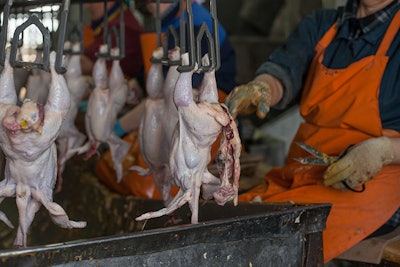
Faster line speeds in poultry processing plants do not increase the risk of Salmonella contamination, finds new research published in Poultry Science.
“The purpose of this research was not to make recommendations, but to find out from data whether establishments with higher line speeds have increased risks of Salmonella contamination when operating under the criteria required to obtain a line speed waiver,” explained study author Dr. Louis Anthony (Tony) Cox, Jr., in association with the University of Colorado Denver.
“The discovery that they do not have increased risks, at least under the current system, suggests to me that appropriate inspection and risk management practices do make it possible to operate at higher line speeds without thereby increasing risks of Salmonella contamination.”
Line speed controversy
Line speeds in poultry and meat processing facilities have been controversial since the adoption of new inspection rules in 2014. Previously, one federal inspector was required for every 35 birds that cross the slaughter line each minute; with the total number of birds allowed to pass through is capped at 140 per minute, requiring four federal inspectors.
The newer rules require one federal inspector on the line, with other inspection responsibilities falling to plant employees. Initially, speeds would increase to allow 175 birds to pass by every minute, but after pushback from lawmakers and activist groups, that number stayed at 140 bpm. After being lobbied by the industry, a line speed waiver was introduced, allowing some plants to operate faster under certain conditions.
“For me, a key take-away is that the inspection and risk management systems now in place following the U.S. Department of Agriculture (USDA) Food Safety and Inspection Service (FSIS)'s implementation of the New Poultry Inspection System (NPIS) in 2014, together with the criteria required to obtain regulatory waivers under the Salmonella Initiative Program (SIP), appear to be effectively managing risks of Salmonella contamination even at higher slaughter line speeds,” Cox said.
Data analysis
The research applied a combination of statistical and machine-learning techniques applied to data collected from 97 poultry slaughterhouses from the years 2018 and 2019 to evaluate if there was a link between faster line speeds and the frequency of positive Salmonella samples.
“I used traditional statistical methods such as regression to explore statistical associations in the data. I also applied modern artificial intelligence and machine-learning (AI/ML) methods that are increasingly being used in risk analysis. These AI/ML methods make fewer assumptions and are better able than traditional statistical methods to control for multiple interactions among variables in quantifying the contribution of a single factor, such as line speed, to outcomes such as risk of Salmonella contamination,” Cox said.
The results “indicate that establishments with higher line speeds do not have higher risks of Salmonella contamination on carcasses when these establishments are operating under the process control criteria required to obtain a line speed waiver, even after accounting for other variables such as establishment size and time since line speed waivers were granted,” he continued.
Like what you just read? Sign up now for free to receive the Poultry Future Newsletter.

















